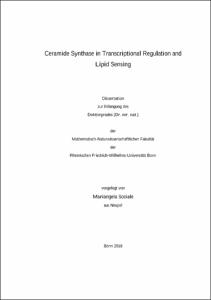Sociale, Mariangela: Ceramide Synthase in Transcriptional Regulation and Lipid Sensing. - Bonn, 2019. - Dissertation, Rheinische Friedrich-Wilhelms-Universität Bonn.
Online-Ausgabe in bonndoc: https://nbn-resolving.org/urn:nbn:de:hbz:5n-54540
Online-Ausgabe in bonndoc: https://nbn-resolving.org/urn:nbn:de:hbz:5n-54540
@phdthesis{handle:20.500.11811/7921,
urn: https://nbn-resolving.org/urn:nbn:de:hbz:5n-54540,
author = {{Mariangela Sociale}},
title = {Ceramide Synthase in Transcriptional Regulation and Lipid Sensing},
school = {Rheinische Friedrich-Wilhelms-Universität Bonn},
year = 2019,
month = may,
note = {Ceramide synthases (CerS) are highly conserved transmembrane proteins necessary for sphingolipid biosynthesis. CerSs carry a TLC (Tram-Lag1-CLN8) domain, containing a conserved Lag1p motif required for ceramide synthesis. Many of the CerS enzymes also contain a homeodomain. Although homeodomain proteins are known to regulate transcription via DNA binding, the homeodomain function of CerSs is frequently not investigated and previous studies doubted that it could act as a transcription factor.
Recently, it has been shown that the Drosophila homologous of CerS called "Schlank", is not only involved in sphingolipid biosynthesis but also in the regulation of body fat. Moreover, the regulation of body fat is independent of CerS activity.
Besides localizing at the endoplasmic reticulum, as each mammalian CerSs, Schlank also localizes at the inner nuclear membrane (INM). Two nuclear localization sites (NLS1, NLS2) are necessary for the nuclear localization of the protein.
In order to distinguish the homeodomain function from the catalytic one, in vivo homeodomain animal models were generated and analyzed. The mutation in the NLS2 site severely affected lipolysis and development, demonstrating an essential function of the Schlank homeodomain in the regulation of body fat metabolism and growth.
This work shows that Schlank binds the promoter regions of lipases (e.g., lip3) via the homeodomain and directly regulates transcription. Mutations of the NLS2 site led to loss of DNA binding and deregulated gene expression. This mechanism seems to be conserved in mammalian CerS2.
Furthermore, Schlank adjusts transcriptional regulation according to the energy status. Upon starvation, nuclear localization and consequently DNA binding diminish. On the other hand, Schlank responds to changing fatty acid levels (essential molecules in sphingolipid biosynthesis), increasing nuclear localization and regulating gene expression.
This study demonstrates a double function of CerS Schlank as an enzyme and a transcriptional regulator, sensing lipid levels and transducing the information to the level of gene expression. This function is required to adjust and maintain lipid homeostasis.},
url = {https://hdl.handle.net/20.500.11811/7921}
}
urn: https://nbn-resolving.org/urn:nbn:de:hbz:5n-54540,
author = {{Mariangela Sociale}},
title = {Ceramide Synthase in Transcriptional Regulation and Lipid Sensing},
school = {Rheinische Friedrich-Wilhelms-Universität Bonn},
year = 2019,
month = may,
note = {Ceramide synthases (CerS) are highly conserved transmembrane proteins necessary for sphingolipid biosynthesis. CerSs carry a TLC (Tram-Lag1-CLN8) domain, containing a conserved Lag1p motif required for ceramide synthesis. Many of the CerS enzymes also contain a homeodomain. Although homeodomain proteins are known to regulate transcription via DNA binding, the homeodomain function of CerSs is frequently not investigated and previous studies doubted that it could act as a transcription factor.
Recently, it has been shown that the Drosophila homologous of CerS called "Schlank", is not only involved in sphingolipid biosynthesis but also in the regulation of body fat. Moreover, the regulation of body fat is independent of CerS activity.
Besides localizing at the endoplasmic reticulum, as each mammalian CerSs, Schlank also localizes at the inner nuclear membrane (INM). Two nuclear localization sites (NLS1, NLS2) are necessary for the nuclear localization of the protein.
In order to distinguish the homeodomain function from the catalytic one, in vivo homeodomain animal models were generated and analyzed. The mutation in the NLS2 site severely affected lipolysis and development, demonstrating an essential function of the Schlank homeodomain in the regulation of body fat metabolism and growth.
This work shows that Schlank binds the promoter regions of lipases (e.g., lip3) via the homeodomain and directly regulates transcription. Mutations of the NLS2 site led to loss of DNA binding and deregulated gene expression. This mechanism seems to be conserved in mammalian CerS2.
Furthermore, Schlank adjusts transcriptional regulation according to the energy status. Upon starvation, nuclear localization and consequently DNA binding diminish. On the other hand, Schlank responds to changing fatty acid levels (essential molecules in sphingolipid biosynthesis), increasing nuclear localization and regulating gene expression.
This study demonstrates a double function of CerS Schlank as an enzyme and a transcriptional regulator, sensing lipid levels and transducing the information to the level of gene expression. This function is required to adjust and maintain lipid homeostasis.},
url = {https://hdl.handle.net/20.500.11811/7921}
}






